Alebrijes: A 10 Minute Guide To Oaxaca’s Unique Art-Form
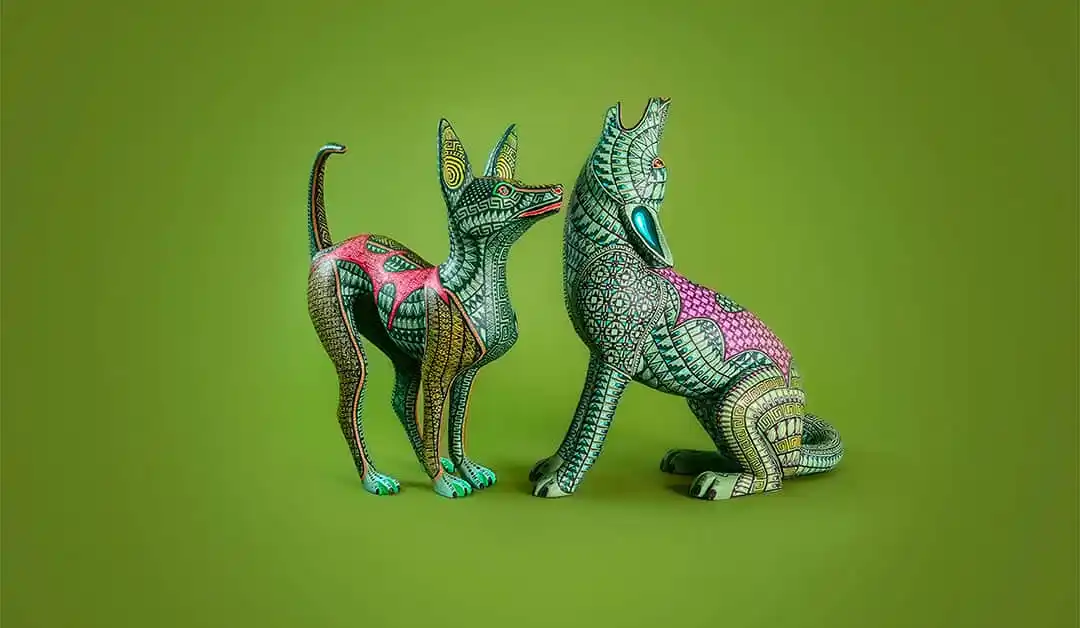
Disclosure: This post may contain affiliate links, meaning that I may get a small commission if you decide to make a purchase through my links, at no cost to you.
If you are in Oaxaca, you will have seen an Alebrije, even if you didn’t know it by that name. In fact they’re so eye-catching that the chances are good that you bought one as a souvenir!
Alebrijes are figures of mythical or fantastic creatures crafted from papier-mâché or carved wood by artisans in Mexico. They are vibrantly colorful and come in all shapes and sizes. They are also all hand-made, so that no two are alike.
Although many believe otherwise, the culture of crafting and displaying Alebrijes is actually a relatively recent development. However, despite their youth, Alebrijes are immensely popular and have become deeply integrated in Oaxacan culture.
Want to learn about this unique art form? We’ve set out below a guide covering everything you need to know about Alebrijes.
Brief Introduction
Before we dive in, let’s briefly look at the word “Alebrijes” itself and answer a few frequently asked questions.
How to Pronounce the Word “Alebrijes”
“Alebrije” is a Mexican word, and is pronounced “a-le-bri-he”, with the accent on the second to last syllable. In the Spanish language, the “j” is pronounced as a heavily aspirated “h”.
Does “Alebrijes” Have an Engish translation?
No, it doesn’t. As you will read below, the word “Alebrije” is an example of onomatopoeia.
The Legend of Alebrijes
Alebrijes have a very curious history, one which only serves to increase their mystique.
The father of Alebrijes is generally accepted to be Pedro Linares López, who was born in Mexico City in 1906 into a family of cardboard artisans (cartoneros). He and his family created and sold masks, piñatas, skeletons, and figures from papier-mâché.
In 1936, when López was 30 years old, he became very ill. He developed a high fever, and fell into a feverish sleep.
Legend has it that during his vivid fever dreams, López found himself walking in a strange forest. Whilst in the forest, he encountered an array of brightly coloured strange and fantastic creatures. He saw a donkey with wings, a lion with a dog’s head, and even a rooster with the horns of a bull.
According to the legend, all of the creatures that he met screamed “Alebrijes! Alebrijes! Alebrijes!” over and over.
Eventually, López recovered from his illness, but his vivid dreams had left an indelible impression on him. When he returned to work, he decided to use his skills to create the creatures that he had seen in his dreams.
And so it was that Alebrijes were born into the world.
The Rise to Fame of Alebrijes

Source: Universidad Autónima de Taumalipas
Back again in the land of the living, López set about trying to recreate the fantastic creatures of his near-death fever dreams. The process was not a simple one, and López had many failed attempts. However, he persevered, and was ultimately able to find the exact papier-mâché forms and the precise colours to bring exact representations of his creatures, his Alebrijes, to life.
Once he had succeeded in reproducing the creatures of his dreams, López then began to market his products. He spent most of the remainder of his life showing his Alebrijes to anyone and everyone. He began with his family, his friends, and his nearest and dearest, but showed them to anyone interested.
Such was the beauty and originality of his Alebrijes that López was invited many times to the US, Europe and other lands to show his wonderful works of art. Famous Mexican artists such as Frida Kahlo and Diego Rivera were so enchanted by his creations that they commissioned him to produce works for their personal collections. Those pieces are preserved today in the Museo Anahuacalli in Mexico City.
In 1975, the British filmmaker Judith Bronowski, who was fascinated by Alebrijes, made a documentary film on López’s work. The film was a great success, and López and his Alebrijes were launched into fame both within Mexico and internationally.
In recognition of his work, López was honoured in 1990 with the National Award for Sciences and Arts, in the category of Arts and Popular Traditions.
López died in 1992 at the age of 85. However, before he left this world, he passed on his technique for creating Alebrijes, which his family continues to this day.
The Rise of Oaxacan Alebrijes
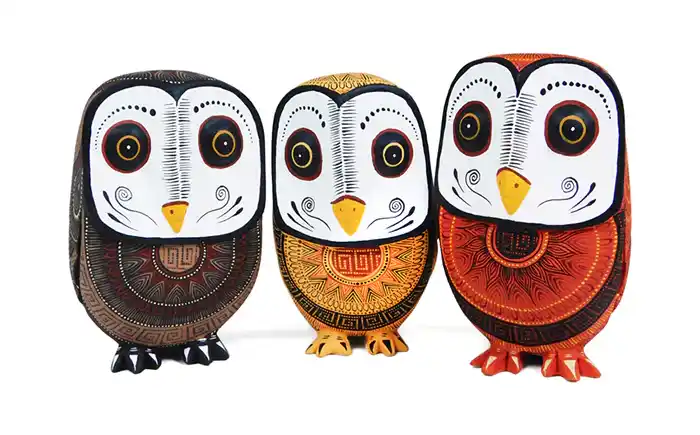
Source: www.sandiafolk.com (artist: Rocio Fabian)
Although Alebrijes were first created in Mexico City, many other parts of Mexico adopted the concept once it began to become well-known. The most famous of these was the state of Oaxaca, which produces some of most spectacular examples of Alebrijes in Mexico.
Many Oaxacan families are artisanal families, passing from generation to generation the knowledge required to craft Alebrijes. Children grow up witnessing the artisanal process as part of their family environment. They see the piles of copal wood used for carving, learn to use the necessary tools to carve them, and watch as the carved figures are painted.
As a result of this artisanal tradition, Oaxaca has an abundance of talented artists of Alebrijes. There are three villages in the vicinity of Oaxaca de Juárez that devote themselves almost entirely to their production. These are San Antonio Arrazola, San Martín Tilcajate and La Unión Tejalapan.
It is in the first of these villages that the Oaxacan history of Alebrijes began.
Manuel Jiménez Ramírez

Source: www.fofa.us
The father of Oaxacan Alebrijes is Manuel Jiménez Ramírez. Ramírez was born in the town of San Antonio Arrazola, a few miles to the south of Oaxaca de Juárez.
Unlike Pedro Linares López, Ramírez was a skilled wood-carver, rather than a cartonero. Ramírez used his skills carving Oaxacan copal wood to create a distinctive type of wooden Alebrije.
Ramírez’s process for creating a wooden Alebrije from copal wood was very successful, and became the model for the production of Oaxacan Alebrijes.
Zapotec Cultural Influence

Source: www.fofa.us (artist: Manuel Jiménez Ramírez)
In addition to changing the base material of Alebrijes, Ramírez and other Oaxacan artisans began to incorporate aspects of Zapotec culture into their Alebrijes as well.
In Zapotec culture, it is believed that every human being is accompanied into life by a spirit animal. The spirit animal will guide and protect that person until he leaves this world. Such spirit animals are known as tonas.
In the Zapotec calendar, there is one tona per each day in a period of 20 days, somewhat similar to a zodiac calendar. Once one 20-day cycle ends, the next one begins.
Well before the arrival of Alebrijes, Oaxacan artisans had traditionally carved tonas from copal wood. Traditional dyes made in the Oaxaca region were also used to paint or stain the tonas.
Another tradition that was incorporated into the Oaxacan Alebrijes was the carving of figurines and masks for shaman, known as nahuales. According to tradition, such nahuales could transform themselves into animals or take on animal traits.
These existing traditional practices were adapted and applied by the local Oaxacan artisans in a modified way to the burgeoning trade in Alebrijes.
Other Cultural Beliefs
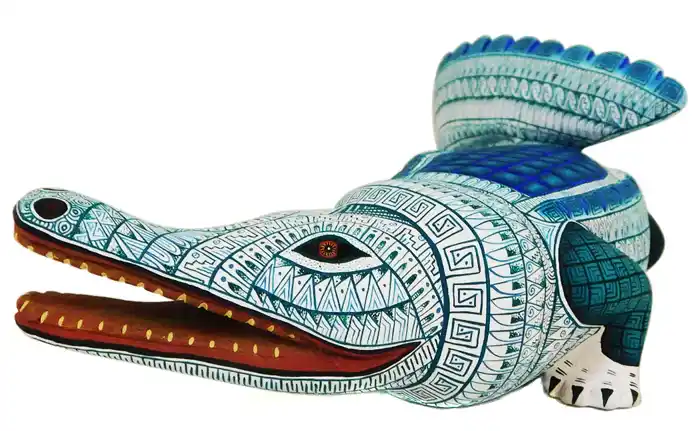
Source: www.sandiafolk.com (artist: Isabel Fabian)
Over time, Oaxacan Alebrijes have also developed some more modern cultural aspects.
In many cultures, there is a belief that certain magic can be used to dispel evil spirits. In some cultures, loud clapping of the hands is used to achieve this, in others a particular statue or figure may be used.
In Oaxaca, many that believe that Alebrijes, particular those that look terrifying, can ward off evil spirits. For that reason, they are often given as gifts, similar to a good-luck charm.
Modern Oaxacan Alebrije Culture
The immense popularity of Oaxacan Alebrijes has seen it burst onto the world stage in almost every conceivable medium.
We’ve set out just a few below.
Day of the Dead Festival
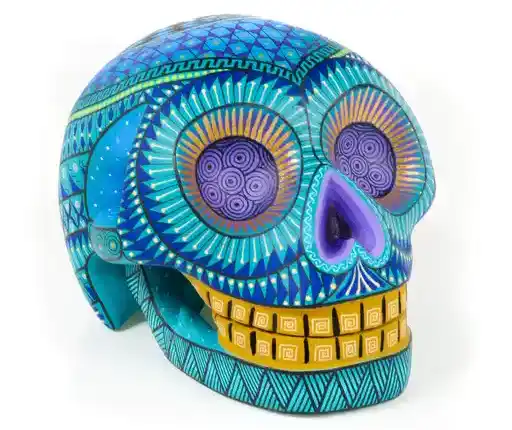
Source: www.vivamexico.com (artists: the Roque family of Oaxaca)
The Day of the Dead (el Día de muertos) festival is a Mexican tradition, rather than a Oaxacan tradition.
However, in Oaxaca, it is celebrated in a particularly lavish style, and artisans have incorporated Alebrijes into their version of the festival. Many believe that the Alebrijes will help to guide the souls of the departed back to their homes.
Similarly to Mexico City and Uruapan, Oaxaca also holds an annual grand parade of enormous Alebrijes, often with a Day of the Dead theme.
Alebrije Tattoos
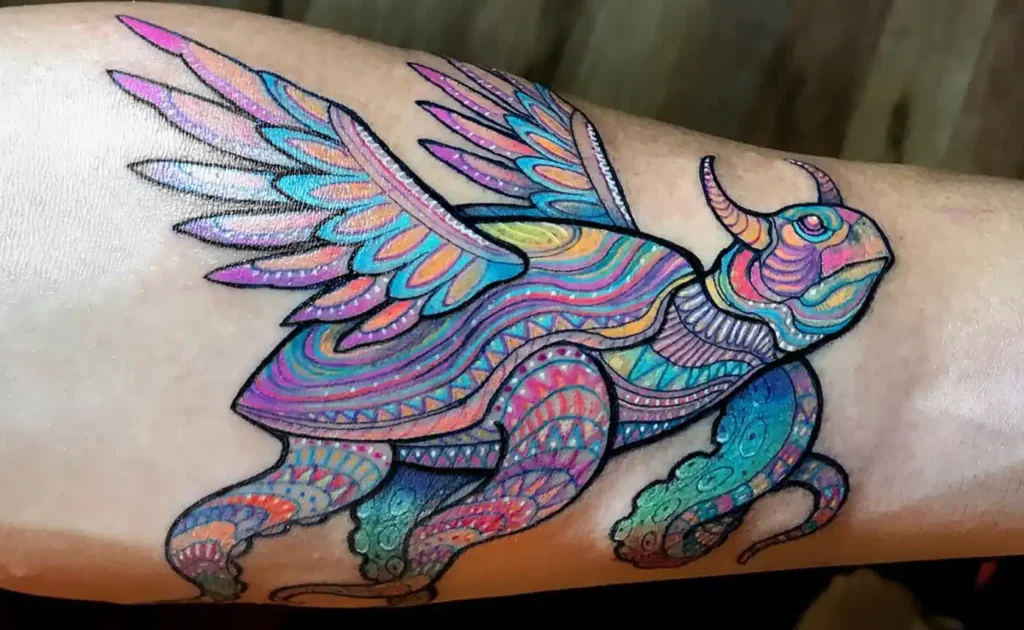
Source: Facebook (Geem Tattoo)
The eye-catching vibrant colours of Oaxacan Alebrijes and their often monstrous and frightening appearance also lend themselves to tattoos. Many also feel a spiritual connection to the elements of Mexican and Zapotec culture incorporated into the designs.
As a result of this, a vibrant cottage industry in tattoos of Alebrijes has grown in Oaxaca, and spread around the world.
Oaxaca Alebrijes Football Team

Source: www.nvinoticias.com
The Oaxaca City football team was recently rebranded to become the Oaxaca Alebrijes, in tribute to the popularity of Alebrijes. It is also a recognition of the association that people around the world see between Alebrijes and the Oaxaca region.
Their current jerseys reflect the beautiful colours and patterns of the locally-produced figures and sculptures.
International Festivals
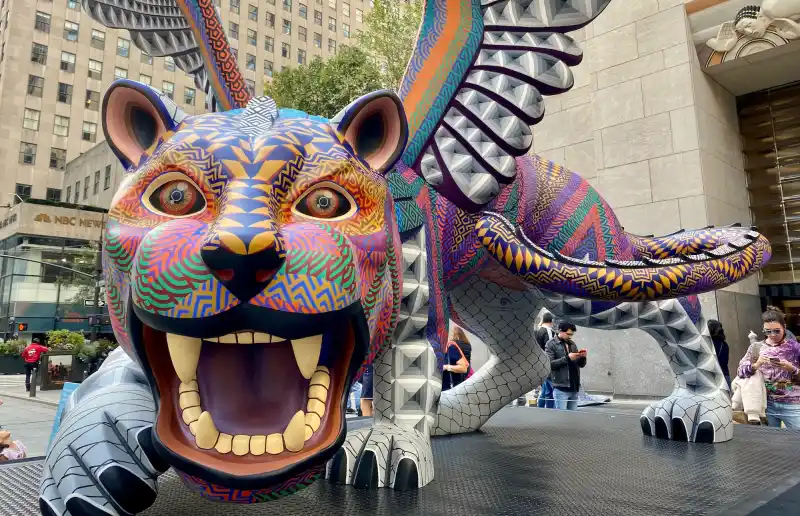
Photo by Valentina Di Liscia (artists: the Jacobo and María Ángeles Workshop)
Alebrijes have become cultural ambassadors for Oaxaca and Mexico as a whole. People love their captivating beauty and Oaxaca’s cultural connection with the metaphysical realm.
Alebrijes have become cultural ambassadors for Oaxaca and Mexico as a whole. People love their captivating beauty and Oaxaca’s cultural connection with the metaphysical realm.
Films
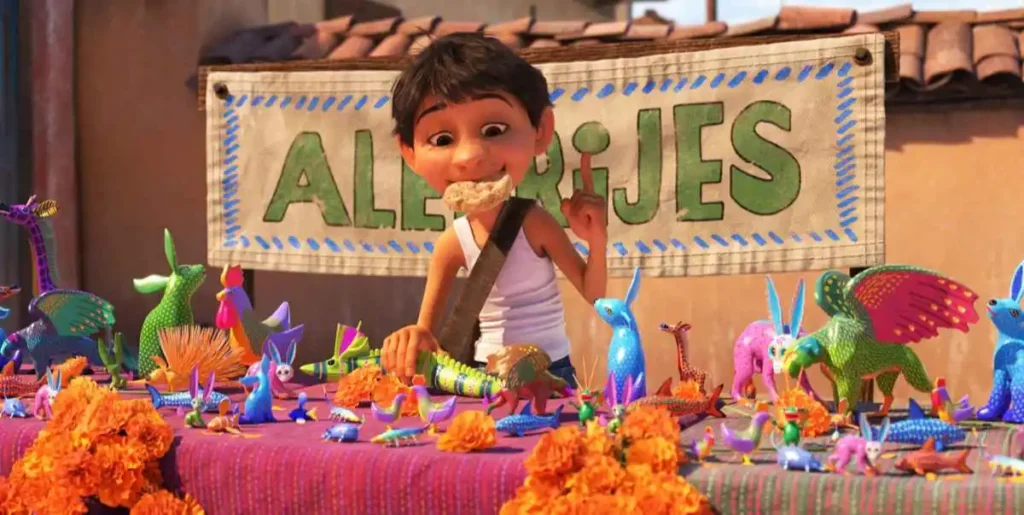
Source: www.pixar.com (film: Coco)
Alebrijes were also prominently incorporated into the recent beautifully colorful Pixar film Coco.
Before deciding to incorporate Alebrijes into their film, the Coco visited the Jacobo and María Ángeles Workshop in San Martín Tilcajete and witnessed the creation of Alebrijes firsthand. It is also believed that some of the characters in the film are also based on artisans at the Jacobo and María Ángeles Workshop, or other residents of San Martín Tilcajete.
How are Oaxacan Alebrijes made?
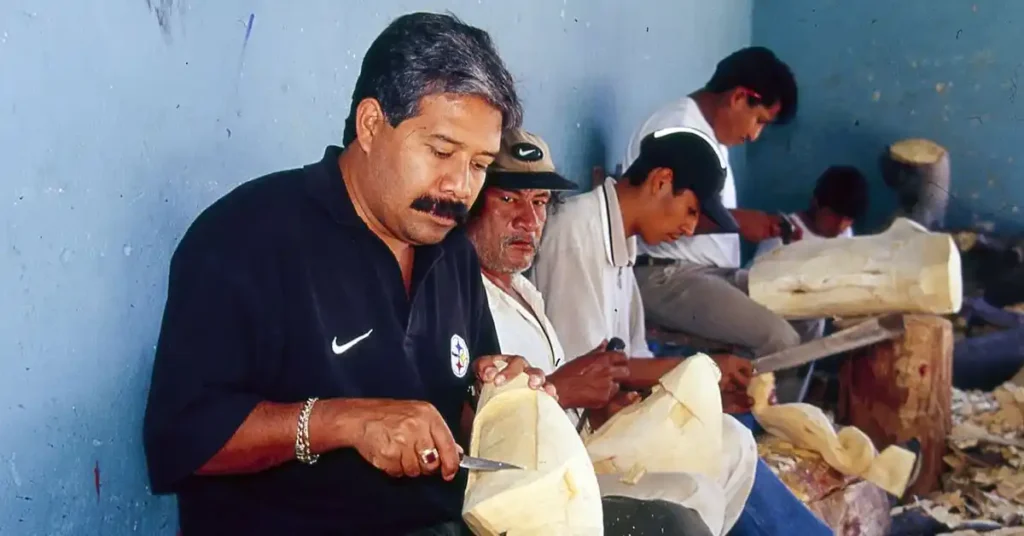
Source: www.fofa.us
There are three steps in the creation of a Oaxacan Alebrije. First, the wood needs to be selected, and the piece carved. Second, the carved piece needs to be sanded smooth and any cracks or holes filled. And lastly, the piece then needs to be painted.
Wood Selection and Carving
The type of wood typically used in Oaxacan Alebrijes is copal wood, which grows locally in Oaxaca. One notable exception to this was Manuel Jiménez Ramírez, who used Guatemalan cedar in his later years, in order to distinguish his work from other Oaxacan Alebrijes.
There are around 100 different species of copal wood in Mexico. Artisans typically use a softwood, medium-sized tree of about 12 metres in length. Trees of that type and age are preferred by the Oaxacan artisans as a medium for carving.
The wood is carefully selected, taking into account its texture, density, and overall quality. The copal tree naturally grows with bends and twists. Some artisans will specifically choose a tree with bends and twists if it would work with their desired creation.
Although copal wood is a soft, malleable wood, it becomes more difficult to work soon after being cut down. For this reason, most copal wood is carved quickly by artisans, usually within a week of cutting.
All carving is carried out with hand tools such as chisels, knives and other carving tools. No machinery can be used, as the product must be produced by hand in order to bring the Alebrije to life.
Sanding and Paint-Preparation
Traditionally, Alebrijes would be produced by families of artisans. As such, the division of labour would typically be that the men would prepare and carve the wood, the children would sand the carving and fill any cracks and holes, and the women would then paint the sanded figure.
In modern workshops, the task of sanding is often also delegated to an apprentice or other unskilled labour. Some wood-carvers also prefer to paint their own Alejibres, notably Angélico Jiménez Hernández and Isaías Jiménez Hernández, the sons of Manuel Jiménez Ramírez.
During the carving process, it is not unusual for cracks in the wood to appear as the wood dries. Small slivers of wood left over from the carving process are often used to fill the holes.
Sawdust from the sanding is then mixed with glue to form a wood paste, which is then smeared over the holes.
The sanding process continues until all cracks are filled and all edges are smoothed down and ready to be painted. The figure must be completed clean and dry before painting can begin.
The Painting Process
Traditionally, paints would be created using natural materials available in Oaxaca. These come from various different sources.
The bark of the copal tree can be charred and then ground to produce an ochre-like powder. That material can then be mixed with other materials, such as sea salt, lime juice, or baking soda to produce various colours. For brighter colors, dried pomegranates, cochineal, añil or indigo are used.
To prevent the colors from fading over time, a mixture of honey and liquified copal resin is added to the colors, which acts as a natural lacquer.
In modern times, acrylic paints are now often used in place of the more traditional paints.
Each color is carefully chosen by the artisan to create a harmonious composition, reflecting traditional Zapotec symbolism and the individual artist’s unique style. Red typically represents vitality and energy, while blue signifies purity and harmony.
Artisans may also adorn the sculptures with accents such as feathers, precious stones, or gold leaf.
The painting process requires is intricate, and requires patience and precision. The most minor details can often significantly enhance the striking beauty of the Alebrije.
Papier-Mâché Alebrijes
Although not the primary method of producing Alebrijes in Oaxaca, papier-mâché techniques pioneered in Mexico City are also used to create Alebrijes in Oaxaca.
The initial preparation steps are obviously very different from that of a wood-carved Alebrije. Rather than starting with a piece of copal wood, artisans first make a base structure for the Alebrije using wire or a combination of cardboard and wire.
Paper strips are then mixed with a glue mixture and are carefully layered and adhered to the wire structure, gradually building the creature’s shape.
Once the structure has been created, the papier-mâché is left to dry. Once dried, the artists apply a layer of white paint to prime the sculpture.
Once the priming layer is completely dried, the artisans then add the vibrant colors and intricate designs used in the carving of the wooden, more typical Oaxacan Alebrijes.
Alebrijes Elsewhere in Mexico
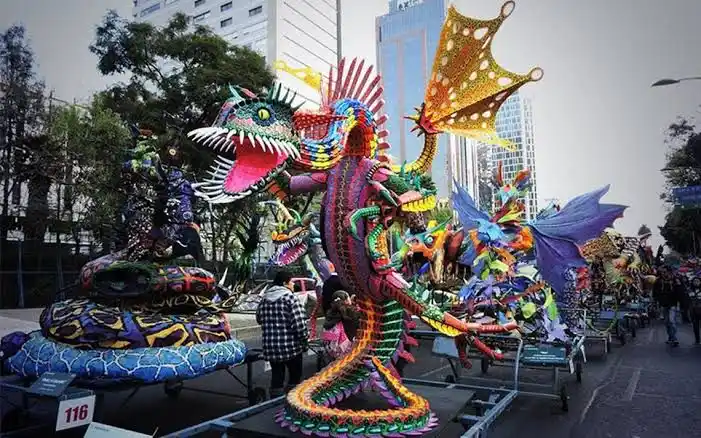
Source: www.diarioabcdemichoacan.com.mx
In addition to the vibrant examples found in Oaxaca, Alebrijes can also be found in other parts of Mexico, particularly in Mexico City and in Michoacán.
The Alebrijes of Mexico City remain heavily influenced by their creator, Pedro Linares López, and typically continue to be made from papier-mâché. The neighborhood of San Angelo is particularly famous for its Alebrijes market, and the National Museum of Anthropology also features Alebrijes in its exhibitions.
The city of Uruapan has the deepest tradition of Alebrijes in Michoacán. Similar to Oaxaca and Mexico City, Uruapan holds its annual Festival de Velas, which includes a dazzling grand parade of its enormous Alebrijes (El Desfile de Alebrijes Monumentales).
Where Can You Find Alebrijes?
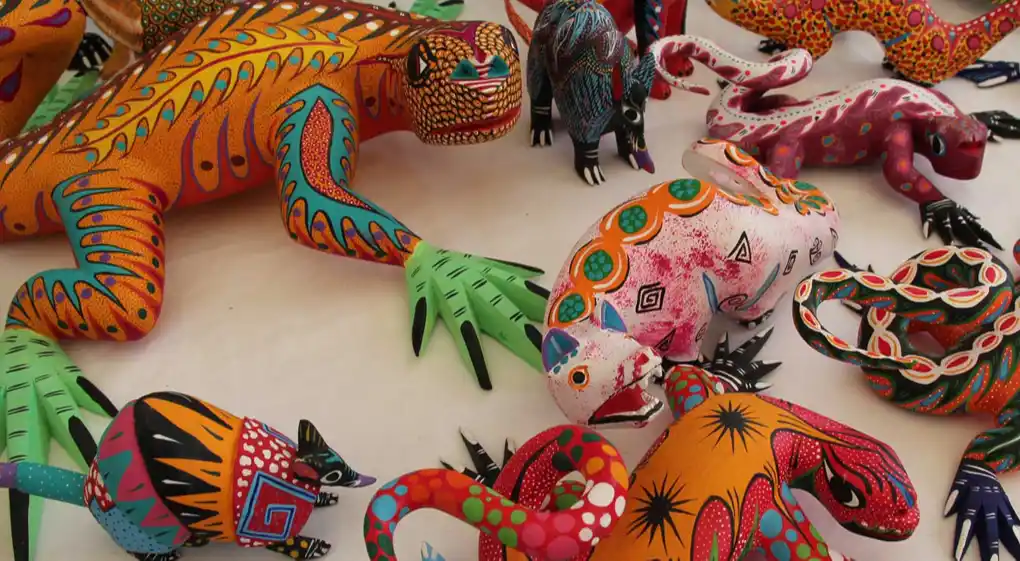
Source: www.xucuri.com
The best place to find the best range of authentic Oaxacan Alebrijes at the best price is in Oaxaca.
If you want to buy them retail, you can find them in the Mercado de Artesanías, or in countless other markets or shops in Oaxaca.
Alternatively, you could take a day-trip out of Oaxaca into nearby San Antonio Arrazola, San Martín Tilcajate or La Unión Tejalapan. In each of these small villages, local artisans produce Alebrijes in their workshop, and you may be able to buy them directly from the artisans.
Many of the best hotels in Oaxaca offer tours to the local workshops, where you can learn how to craft your own Alebrije, or buy a souvenir directly from the artisanal family.
If you want to buy online, you can do so, although you should ensure that you are buying from a reputable seller. The Jacobo and María Ángeles Workshop is one of the most well-known in Oaxaca.
How Much Do Alebrijes Cost?
Like any artisanal craft product, the price of an Alebrije varies widely. Consequently, the price can range from a few US$ for a small generic figurine, to several thousand for a larger, more intricate or personalised piece.
Broadly speaking, the cost of an Alebrije has several components. These are the cost of goods, labour cost, and the prestige of the artisan family producing the pieces.
Cost of Goods
The cost of goods includes the copal wood used, any other products used in the creation of the piece, as well as the cost of the paints, varnish and other finishing products.
Clearly, if a small piece is created, the cost of goods is likely to be quite low. However, for a larger more complex piece, the costs can climb quite quickly. Larger pieces require more wood, and may require wood with particular features, such as twisted limbs.
If traditional paint is used, which would be the case in a more high-end piece, then the costs would increase further. Traditional colours will in most cases be more expensive that manufactured hues.
Labour
All Alebrijes are produced by hand. That means that the bigger the product, the more hands are needed!
Labour is not as expensive in Oaxaca as in other parts of the world, and artisans also often work together in families, which means that fewer employees would be required.
But even so, each person working only has so much time per day, and can only work on one piece at the same time. On that basis, if more working hours are spent on a piece, then the price of the Alebrije will be higher.
Artisanal Prestige
In addition to the above, if the Alebrijes are produced by a prominent artisan family, they will generally be more expensive. This is because the demand for the product is higher, and therefore the more prominent families can sell at a higher price.
There are a number of prominent artisan families in Oaxaca, including the Jiménez family (the descendants of Manuel Jiménez Ramírez), the Ojeda family (of which the Jacobo and María Ángeles Workshop is a part), the Santiago family, and the Calvo Fabián family.
What is Your Alebrije?
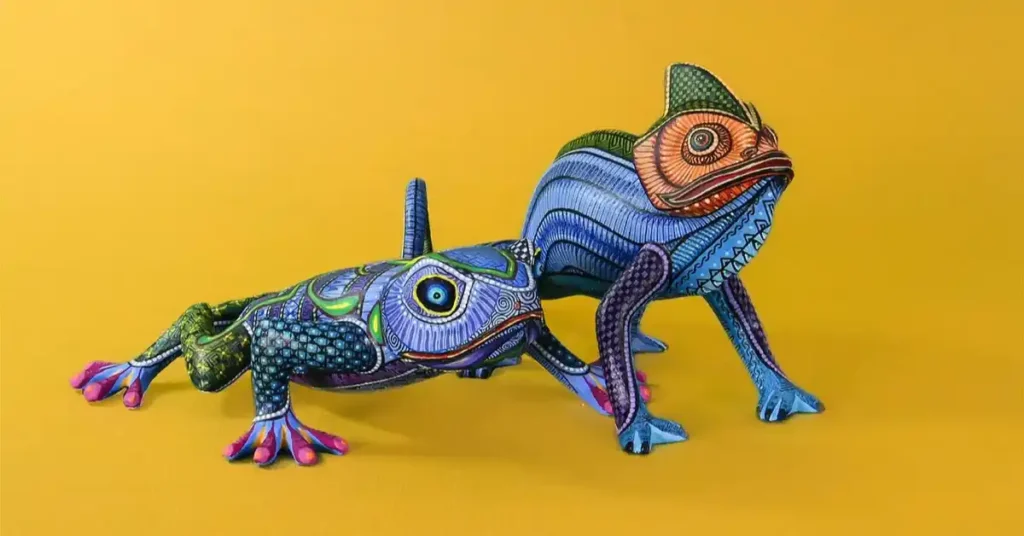
Source: www.jacoboymariaangeles.com (artists: Jacobo and María Ángeles Workshop)
Do you want to know what your Alebrije is?
Like the Zodiac calendar, your spirit animal will be determined by your birth date. The Zapotec calendar is composed of 13 months integrated by 20 days. Each day is ruled by an animal, in a cycle that repeats itself month after month every 20 days.
The Jacobo and María Ángeles Workshop carried out extensive research on a copy of the Zapotec calendar in the Museo de las Culturas de Oaxaca. Following their research, they then identified 20 animals that they now use to create Alebrijes as Zapotec tonas.
If you are interested, you can reach out to the workshop, and they can start working on your own personal Alebrije!
Final Thoughts
Alebrijes have captured the imagination of art enthusiasts around the world. However, in Oaxaca, they have become a distinctive part of the culture.
By applying their traditional expert carving and painting techniques to the new Alejibre concept, the Oaxacan artisans have brought their creatures to life in the eyes of the world. The connection with the pre-Hispanic Zapotec culture also strikes a chord with people, extending the significance of Alebrijes beyond their aesthetic appeal.
Alebrijes now represent the cultural heritage and traditions of the Oaxacan people. They have been integrated into traditional festivals such as the Day of the Dead, are exhibited daily in museums around the world, and have reached Hollywood. They even have their own football team!
From humble beginnings, they have very much taken the world by storm, and have become a very important aspect of the Oaxacan economy.
Curious? Why not see them for yourself? Plan your trip now, and find out which are the best hotels in Oaxaca and what are the best things to do once you get there!
![Puebla to Mexico City: 8 Best Ways To Travel [2024]](https://capricioustravel.com/wp-content/uploads/2024/01/Puebla-to-Mexico-City-Puebla-Cathedral-and-Palacio-de-Bellas-Artes.webp)
![Guadalajara to Oaxaca: 6 Best Ways To Travel [2024]](https://capricioustravel.com/wp-content/uploads/2024/01/Guadalajara-to-Oaxaca-Guadalajara-Cathedral-and-Oaxaca-Templo-de-Santo-Domingo-de-Guzman.webp)
![Hotel Abu Oaxaca: The Definitive Review [2024]](https://capricioustravel.com/wp-content/uploads/2023/12/Hotel-Abu-Oaxaca-Street-Time-Lapse-1-800x450.webp)
![Hotel Escondido Puerto Escondido: The Definitive Review [2024]](https://capricioustravel.com/wp-content/uploads/2023/10/Hotel-Escondido-Puerto-Escondido-Terrace-at-Sunset-800x450.webp)
![Oaxaca to Huatulco: 7 Best Ways to Travel [2024]](https://capricioustravel.com/wp-content/uploads/2023/09/How-To-Get-From-Oaxaca-To-Huatulco-800x450.webp)
![Hotel Con Corazón Oaxaca: The Definitive Review [2024]](https://capricioustravel.com/wp-content/uploads/2023/11/Hotel-Con-Corazon-Oaxaca-Tree-in-Interior-Courtyard-1-800x450.webp)